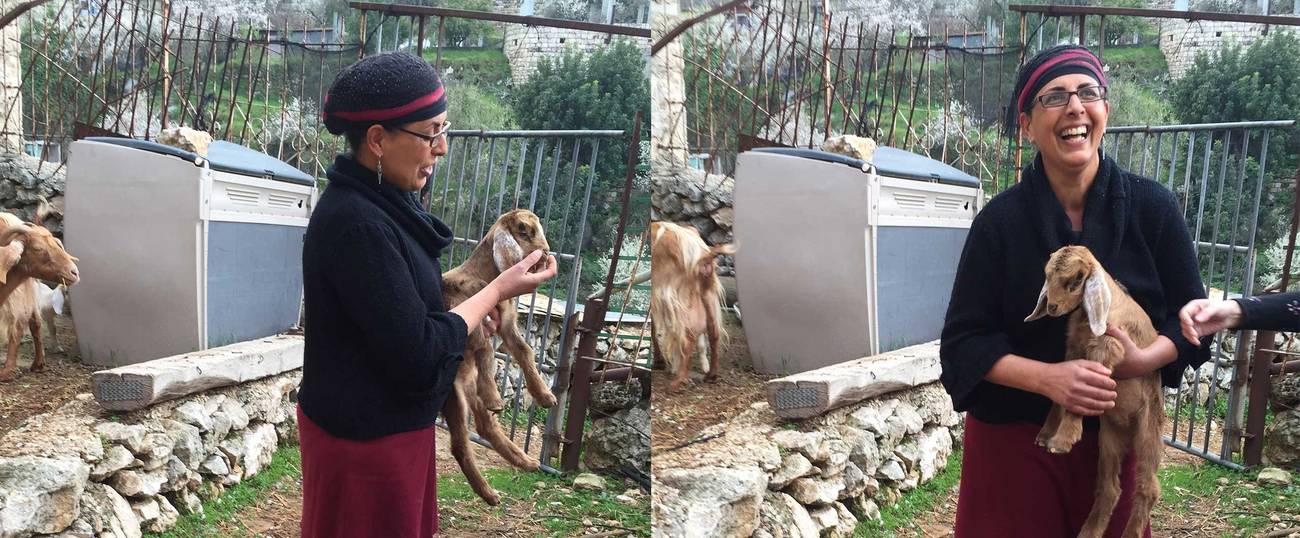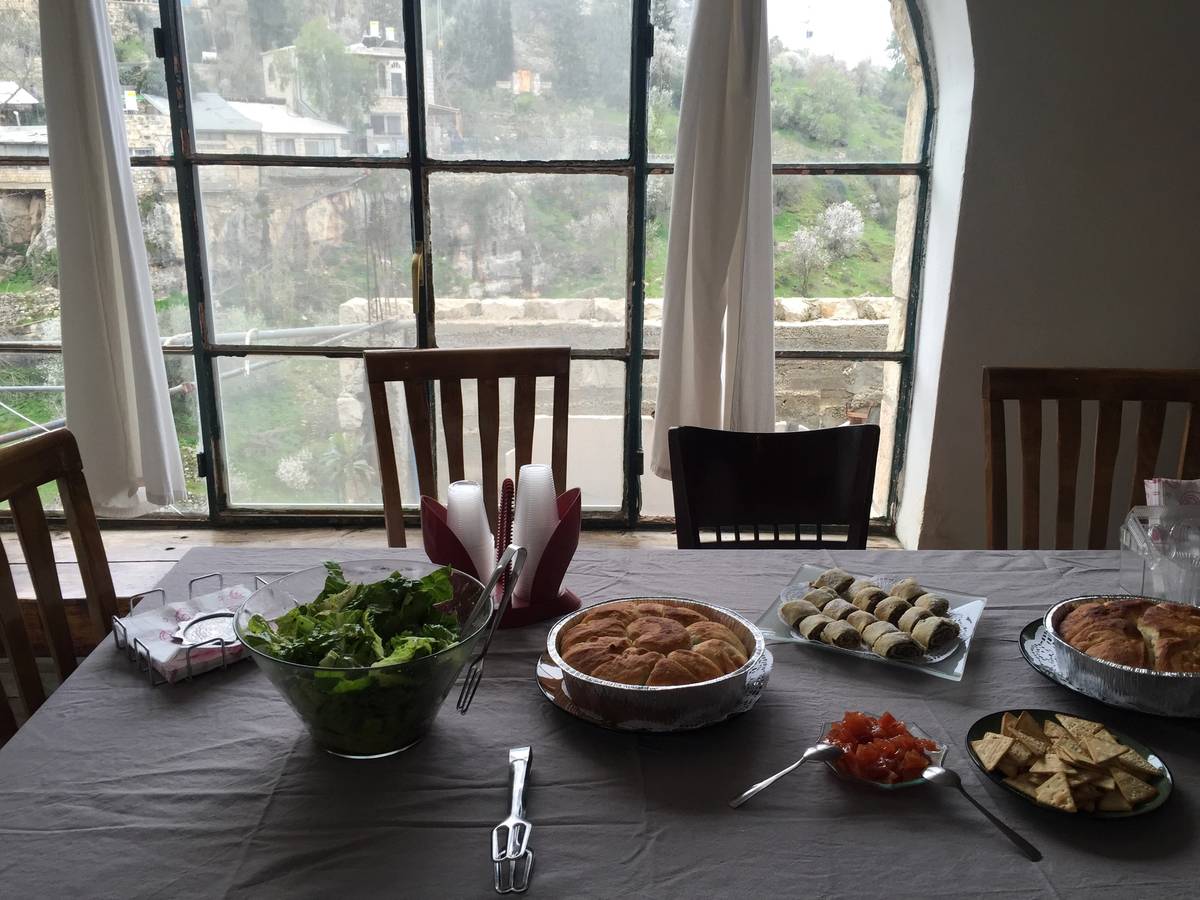Next Stop on the Tour: The Living Room
Women show tour groups different sides of Israel, starting in their own homes




Rivka Brandwein spent a recent Tuesday morning tidying the apartment where she and her husband raised 10 children in Jerusalem’s ultra-Orthodox Bukharim quarter. Platters of cakes and bottles of juice were arranged on the table. Chairs were set in a large circle around the room, ready for about 30 guests. The nostalgic song “My Yiddishe Mama” played in the background as her guests, a group of liberal arts students from Jerusalem’s Shalem College, filled the living room.
The rabbis from Brandwein’s Boyan Hasidic sect have banned college attendance for their community members, but this 58-year-old grandmother was eager to meet these students, to show them her world. She was hosting the students as part of a new community initiative to introduce tourists and other visitors to the Haredi way of life.
“Sit down, sit down, feel at home,” Brandwein said, smiling. “Feel like you are at the home of a Yiddishe Mama.” She passed out photo albums from family weddings, and the students—all female; their male classmates have been sent to a different home nearby—paged through them. Brandwein told a brief version of her life story, about growing up nearby in the Mea Shearim neighborhood, marrying at age 18, and now getting ready to marry off her youngest daughter later this year.
“I simply want you and other people to come and see us, to see what we are really like,” she told the group. “I want you to see beyond how the media portrays us, as one entity that wears only black and is only made up of extremists.”
The visit to Brandwein’s home was coordinated by the Paam Center, which recently also opened a museum about her neighborhood’s history, and is one of a growing number of initiatives that invite visitors into homes around Jerusalem and Israel as a whole. Such programs aim to expose foreign tourists and Israelis alike to everyday life in a variety of different communities, in an effort to create more understanding among Israel’s diverse and often fractured population, as well as provide a source of income for the hosts. The programs can be found across Jerusalem, and in the Galilee and Negev regions. For now, most who visit these homes are Israeli, but a growing number of foreign tourists are also participating.
The hosts are mainly women. This is due both to prevailing traditions in many sectors of society that it is the woman who runs the home; but also because government-subsidized training courses and other initiatives to encourage this type of tourism focus on women. This “social tourism,” which benefits local residents, is a rising trend globally, said Mina Ganem, senior deputy director for strategy and policy planning at the Israel Ministry of Tourism, which recently began providing training courses for women in Jerusalem interested in hosting tourists in their homes for meals, lectures, craft workshops, and other cultural activities.
“Meeting a local person and talking to them is something you always remember,” Ganem said. “This is a win-win-win situation, for the visitors, for Israeli society, and for the women who host.”
*
Several years ago, a group of women in the west Jerusalem enclave of Ein Kerem, a mountainside neighborhood known for its ancient churches and early Christian history, began hosting tourists in their homes as part of a project called “Nifleot Ein Kerem,” or “The Wonders of Ein Kerem.”
“People came to Ein Kerem to see the churches and eat in a cafe, but didn’t really do anything else here,” said Efrat Giat, a licensed tour guide and mother of five who lives in Ein Kerem, where she raises goats for milk and cheese. Now she is among about a dozen women here who host both Israeli and foreign tour groups in her home. She prepares them meals of buttery, freshly baked Yemenite bread (similar to French brioche), salads, and homemade goat cheeses. Sometimes visitors help her milk the goats.

She often tells visitors the story of how her parents-in-law were settled here by the newly-formed Israeli government when they emigrated from Yemen in 1949, and were given two goats and a chicken to help them start a new life. They were among the new Jewish immigrants who moved into the small stone houses abandoned here by Arab residents during Israel’s war of independence, and lived without running water or electricity until the 1970s.
“My mother-in-law is an amazing woman, so I am telling her story,” Giat said. It is a story unfamiliar to many visitors who simply associate Ein Kerem with churches, restaurants, and nearby hiking trails.
After years of guiding visitors around the sites of Ein Kerem and other areas of Jerusalem, Giat also appreciates not having to leave home to make a salary. “I realized when I was pregnant that it’s better for me to bring the work home instead of walk all around the city,” she said. “I’m still guiding, but in a different way, and a more intimate way.”
Visits are arranged in advance and the prices vary from 50 shekels (about $14) a person for light snacks to more than 200 shekels ($55) for a full meal, craft workshop, or cooking lesson.
The project has also created bonds between the women who host, who didn’t know each other well before. Now they refer clients to each other, or work together to handle a large group, or a group that wants to see multiple homes on the same day.
“This project makes relationships between neighbors and creates a stronger community,” Ganem said.
From Ein Kerem, the idea spread to other neighborhoods, and now about 60 women are hosting around Jerusalem under a program called Women and Tales in Jerusalem, which is supported by the Jerusalem municipality and the tourism ministry. Women come from all sectors of Jerusalem’s population, from religious to secular; from Jewish to Muslim; from immigrant to native-born. Similar initiatives in Druze communities in the north, and Bedouin communities in the south, have also received government support, and a number of other private initiatives have also opened recently.
Samira Aliyan, a Muslim woman born in a West Bank village near Hebron who now lives in Jerusalem’s Beit Safafa neighborhood, recently began hosting groups in her home. It helps bring in extra income, but money isn’t her main motivation. “I love doing this with all of my heart,” Aliyan said. “I love getting to know other people.”
Like Brandwein, Aliyan wants to allow visitors to experience her culture themselves, and break down stereotypes people may have about Arabs or Muslims. “I want to show people a good picture,” she said. “People shouldn’t be afraid to come here.”
Elisa Moed, co-founder of Breaking Bread Journeys, a joint Israeli-Palestinian social tourism initiative that coordinates home visits, said such programs can deepen understanding and forge new relationships. “Going into someone’s home really creates a bond and a deeper level of engagement than just meeting on the street,” Moed said. “I think having these types of close encounters here is extremely important because many people are coming to Israel with a very narrow view.” She added that the food aspect also creates intimacy: “People talk much more openly when their stomachs are full.”
Many of the students who crowded into Brandwein’s living room had never been inside an ultra-Orthodox home. In addition to her history, Brandwein talked about the future, about how more people in her community are learning professions, and more men are working rather than spending all of their time learning Torah in yeshivas.
“The next generation will be very different, and we are worried about that, with all the technology and all the changes,” Brandwein said. The group peppered her, and some of her younger neighbors who also joined, with questions not only about higher education and employment, but about the mandatory Israeli army service, for which the ultra-Orthodox have long been granted exemptions. The visiting group appreciated hearing about these topics, which are often discussed in the media; the low labor-force participation rates among Haredi men are an ongoing challenge for Israel’s economy, and army service is an explosive political topic.
“I was really surprised by how open they were,” said Enya Koblenz, a 25-year-old who grew up on a kibbutz who visited Brandwein’s home. “I got lots of anti-Haredi messages growing up. You are always taught about how they don’t work at all, and that, for a kibbutznik, is like the worst thing.” But Brandwein’s husband does work, as a Torah teacher, and Brandwein talked about being constantly busy to help make ends meet for her family, taking jobs tailoring clothes and teaching others how to sew.
“Hearing her story shows how we are not in our everyday lives exposed to things as they really are,” Koblenz said. “I feel like I expanded my horizons here today.”
***
Like this article? Sign up for our Daily Digest to get Tablet Magazine’s new content in your inbox each morning.
Sara Toth Stub is a Jerusalem-based American journalist who has written for The Wall Street Journal, Dow Jones Newswires, Associated Press, and other publications.